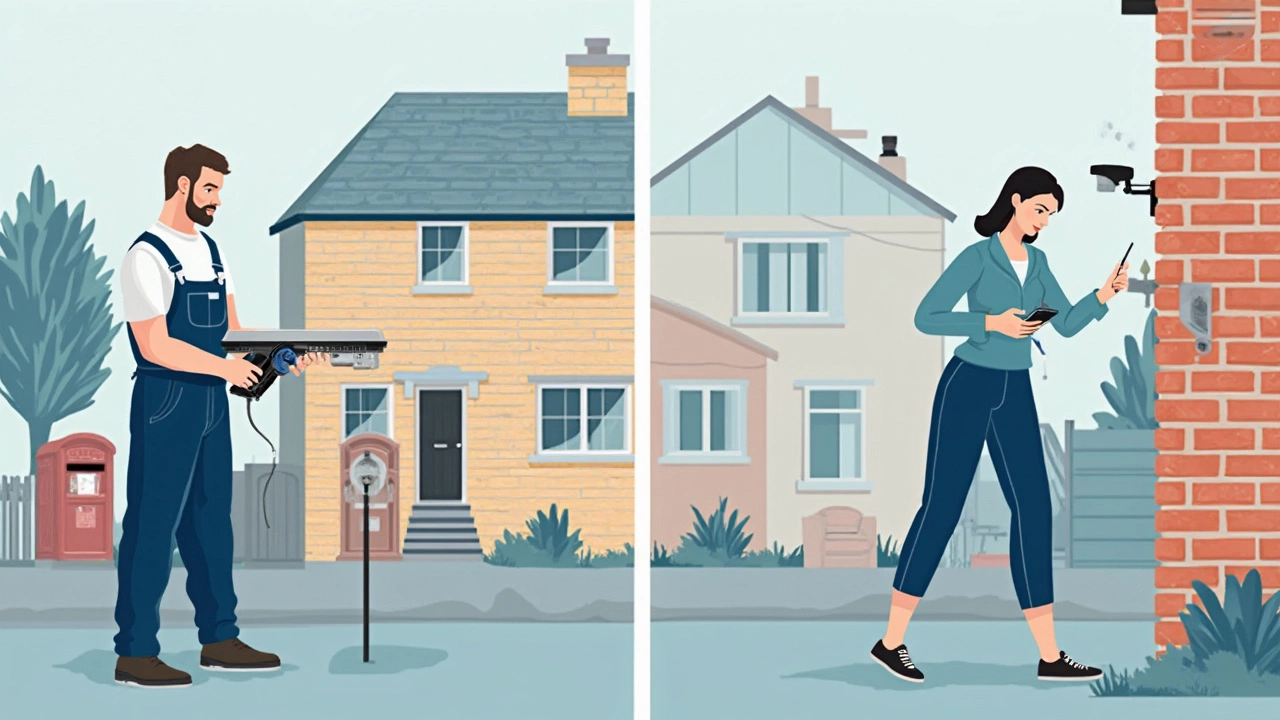If you’re shopping for security cameras, you’re probably stuck at that classic fork in the road: go wired or go wireless? It sounds simple, but it isn’t. The choice you make shapes everything—how easy your setup is, how your camera behaves in a blackout, and even what happens if your Wi-Fi sneezes.
Lots of folks jump on wireless because it seems modern and hassle-free. Truth is, ‘wireless’ doesn’t always mean zero wires. Most wireless cams still need power cables unless you pony up for battery-operated ones (and even that gets old fast if you hate recharging every few weeks). On the other hand, wired cameras are a pain to install, but they almost never lose signal and won’t die just because your router crashed.
- How Wired and Wireless Cameras Work
- Installation: What’s Easier?
- Reliability and Performance
- Security Risks & Privacy Concerns
- Picking What’s Right For You
How Wired and Wireless Cameras Work
When you’re diving into the world of home surveillance, knowing the nuts and bolts of how wired security cameras and wireless models do their thing makes your choice much easier.
Wired cameras run on old-school reliability. They connect to your home network using cables—usually an Ethernet or coaxial cable—which also hooks them up to their power source. These setups plug straight into a digital video recorder (DVR) or network video recorder (NVR), keeping your footage tucked away on a secure hard drive. No Wi-Fi, no fussing about drops in the signal, and no batteries to swap out.
Wireless cameras cut the network cords. They transmit video to your Wi-Fi router and store footage either in the cloud or on a memory card. Some plug into power outlets, while battery-powered models give a cleaner, wire-free look. But there’s a catch: if your Wi-Fi goes down, so does your live feed and recording. Even when powered by a battery, expect to recharge them every few weeks—or even sooner if you’ve got a lot of motion triggering the camera.
Here’s a straight-up comparison to help you see the main differences:
| Feature | Wired Cameras | Wireless Cameras |
|---|---|---|
| Connection Type | Cables (Ethernet/Coaxial) | Wi-Fi (or sometimes cellular) |
| Power | Direct wired | Outlet or battery |
| Installation Difficulty | High – needs drilling and wiring | Low – most just mount and plug in |
| Signal Reliability | Stable (not affected by Wi-Fi) | Depends on wireless network |
| Recording Location | Local DVR/NVR | Cloud or onboard memory |
| Best For | Long-term/permanent setups | Rentals or quick changes |
The big takeaway? Wired setups are usually bulletproof for reliability but can be a beast to install yourself. Wireless cameras are way easier to get going, but they lean hard on your home internet. If your Wi-Fi is sketchy, don’t be surprised if your camera performance is, too.
Installation: What’s Easier?
Setting up a security camera isn’t a one-size-fits-all thing. The installation process is a big reason people feel torn between wired and wireless options. Here’s what you’re really looking at when you get into it.
If you go with wired security cameras, get ready for some heavy lifting—literally. You’ll need to run cables through walls, attics, or crawl spaces. Unless your house was built with wiring in mind (most aren’t), this can eat up an afternoon or worse, force you to call in a pro. On average, pro installation can cost anywhere from $100 to $200 per camera. Not fun if you’re decked out with ten cameras. DIY isn’t impossible, but it’s not for the faint-hearted, especially if you hate getting dirty or handling power tools.
Wireless cameras give you home security without the headache—at least most of the time. Most Wi-Fi cameras mount with just a few screws and can be running in under 15 minutes, especially if they’re battery powered. Ready-to-go apps make initial setup easier than ordering a pizza. But don’t forget: most “wireless” cameras still need a power cord. Full battery-powered cams exist, but you’ll be swapping or charging batteries every month or two, depending on how much they get triggered.
| Type | Installation Time (per cam) | Typical Cost | Tools Needed |
|---|---|---|---|
| Wired | 1-2 hours | $100–$200 (pro install) | Drill, screws, cable tools |
| Wireless (plug-in) | 10-20 minutes | $0–$50 (DIY) | Drill, screws |
| Wireless (battery) | 5-15 minutes | $0 (DIY) | Screwdriver |
Got a rental? Wireless is almost always better—landlords hate holes in the walls. Live somewhere with thick brick or stone walls? Wired installs can be brutal (or straight-up impossible) unless you plan to redecorate.
Tip: Before picking, map out exactly where you want coverage. If your furthest camera is 100 feet from your router, you may need Wi-Fi extenders or special wiring—both can drive up cost and complexity. And if you choose wired, double-check that your system supports Power over Ethernet (PoE)—that way, you only have to run one cable for both power and data.

Reliability and Performance
If you just want your cameras to do the job and not bail on you during a storm, these things actually matter—big time. Wired security cameras are workhorses. Rain, power surge, or the neighbor's Wi-Fi going haywire? Wired cameras just don’t care. They get power and send footage through cables, so their signal doesn’t drop out the minute your Wi-Fi has an off day or your internet provider hiccups.
Wireless cameras, no surprise, depend on your Wi-Fi network. A lot can mess that up: thick walls, microwave ovens, even your smart fridge. If you’ve ever seen a spinning loading icon during a movie night, you get the picture. A 2024 Consumer Reports test found home Wi-Fi cameras lost connection about 7% of the time during busy network hours, while wired models stayed solid. The gap gets bigger in big houses or if your router’s far from the action.
Here’s what most people don’t realize: high-resolution footage eats up bandwidth. Let’s say you want crisp 4K recordings. Wired cameras handle that with no problem. Wireless ones? Sometimes, your video gets all pixelated unless you pony up for a top-tier router or mesh network.
The folks at SafeWise say, "Wired cameras offer unmatched consistency—once they're set up, interruptions are extremely rare. Wireless cameras, on the other hand, can be rock-solid or flaky, depending on your home’s Wi-Fi strength."
Batteries are another story. If you go for a battery-powered wireless camera, you’ll need to keep up with recharging. Most need juice every two to three months. If you skip a charge, you could get spotty coverage at the worst time. Wired cams? They’re always on, as long as your house has power.
Here’s a quick data rundown comparing basic reliability factors:
| Factor | Wired Cameras | Wireless Cameras |
|---|---|---|
| Signal Dropout (per year) | <1% | Up to 10% |
| Resolution Stability | Stable up to 4K | May drop if Wi-Fi weak |
| Coverage in Power Outage* | Needs backup power | Needs strong Wi-Fi + charged battery |
| Latency (Live Feed Delay) | <1 second | 1–5 seconds |
*Both need UPS (battery backup) to work in a blackout.
If you're someone who loves gadgets or moves a lot, wireless cameras offer flexibility. But if you want top-notch wired security cameras that work day in, day out—no drama—wires should seriously be on your radar.
Security Risks & Privacy Concerns
You want your security camera to keep you safe, not make you an easy target. Here’s where things get real: wireless cameras can be hacked if you slack on passwords or the company doesn’t keep up with updates. Wired cameras are tougher to hack remotely because they don’t rely on Wi-Fi, but they’re still not bulletproof—they can be physically tampered with if someone gets access to your property.
Back in 2021, a security firm found that about 30% of owners using wireless cameras had never changed their default password. That's practically an open invitation for hackers. Some high-profile hacks have even led to strangers yelling at kids through bedroom cameras. Not cool. Wired cameras can’t be hijacked from across the world the same way, but nothing’s perfect—someone can just cut the cords if they’re not hidden well.
"Security camera hacks aren’t just rare news stories—they’re a real risk if users don’t regularly update software and use unique, strong passwords," warns cybersecurity expert Brian Krebs.
If you’re wondering how the numbers stack up, check out this:
| Type | Common Attack Type | Chance of Remote Hack (2023) |
|---|---|---|
| Wireless | Wi-Fi intercept, password theft | Medium |
| Wired | Physical tampering, cable cuts | Low |
Want to boost your privacy with any camera type? Here are quick, practical tips:
- Pick a system from a brand with a good track record and regular security updates.
- Change the default password right away—make it long, weird, and unique.
- Turn on two-factor authentication if it’s an option.
- Avoid pointing indoor cameras toward private spaces unless you absolutely have to.
- Keep your camera firmware up to date; don’t ignore those update alerts.
Bottom line: No camera is 100% safe, but with some basic habits, you can seriously lower the odds of creepy stuff ever happening. If you’re really nervous about wired security cameras getting tampered with, tuck the wires out of sight or even inside the walls during install. For wireless, your top job is locking down your router and using strong passwords everywhere.

Picking What’s Right For You
Here’s where it gets real: the best camera setup depends entirely on your house, your internet, and your patience. You won’t find a one-size-fits-all solution here, just trade-offs that matter in the long run. So how do you pick?
Wired security cameras usually win when it comes to stability. These bad boys almost never lose connection, and you won’t have to worry if your Wi-Fi or batteries fail. But you’ll need to deal with running cables through your walls or attic, which often means hiring a pro. That can add up: on average, pro installation bumps your bill by $100–$200 per camera, and can double if you have a big home.
For rentals, apartments, or anyone who wants a quick win, wireless cams are way less hassle. No drilling, just screw them in and link to your Wi-Fi (usually takes ten minutes tops). Most popular battery-powered options last about 2–6 months before needing a recharge. The catch? If your Wi-Fi is spotty, your footage might lag, or the camera could go offline without warning. According to a 2023 report from SafeHome, about 29% of wireless security camera users reported connection interruptions in the last year—that’s not nothing.
You should weigh the most important stuff for you personally. Here’s a quick comparison that helps put things side by side:
| Feature | Wired Cameras | Wireless Cameras |
|---|---|---|
| Signal Reliability | Almost never drops | Depends on Wi-Fi strength |
| Installation | Complex, needs wiring | Easy, DIY-friendly |
| Power Source | Direct (no recharging) | Batteries or power cord |
| Price (Initial) | Higher with install | Lower upfront |
| Works During Outage? | Yes (with local recording) | No (if Wi-Fi/router down) |
One last tip—if you’re leaning wireless, do a Wi-Fi speed test right where you plan to put the camera. If you’re not pulling at least 5 Mbps upload, you’ll probably deal with glitches. Also, check if your camera supports local SD card storage, so footage still gets saved if your network crashes.
Bottom line? Decide what bugs you more: drilling holes and dealing with wires, or occasional headaches from tech flukes and battery swaps. There’s no wrong answer, but there definitely is a better fit for your home, your setup skills, and your peace of mind.

